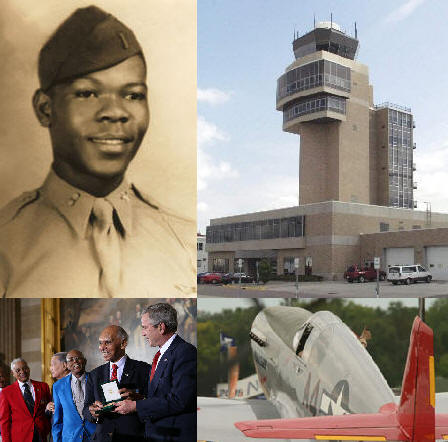
 |
NEWSROOM |
|
|
|
||||
|
Tuskegee Airman And One Of America’s First Black Air Traffic Controllers Vernon Hopson Dies AT 84 By Mike Mitchell |
||||
 |
September 5, 2009: As a young Black man growing up in La Grange, Texas, a small country town during the Great Depression, Vernon Hopson while working in the fields would take notice as aircraft flew overhead. He dreamed that one day he too would become a pilot. Vernon Hopson graduated from high school two years early at which time he joined the Civilian Conservation Corps (CCC), a public work relief program for unemployed men, focused on natural resource conservation from 1933 to 1942. This was part of the New Deal legislation proposed by U.S. President Franklin D. Roosevelt. The CCC was designed to aid the relief of unemployment resulting from the Great Depression while implementing a general natural resource conservation program on national, state, county and municipal lands. While in the Civilian Conservation Corps, Vernon read a newspaper article about the Tuskegee Airmen. He consulted with his high school principal on opportunities and questioned his own intellectual abilities. He was told by his former high school principal that the opportunities were there and he was more than qualified and he should pursue his dream. Vernon’s principal had been involved in flight training but was kicked out of flight school two months before his graduation because he was Black. |
|||
|
When Vernon was old enough he joined the Army Air Force in World War II. He was enrolled in the Tuskegee University Flight Training Program where he became one of many elite Black pilots known as the “Tuskegee Airmen”. Vernon learned how to fly the “Red Tail” P-40 Warhawks and P-47 Thunderbolts. The Curtiss P-40 was an American single-engine, single-seat, all-metal fighter and ground attack aircraft that first flew in 1938. It was used by the air forces of 28 nations, including those of most Allied powers during World War II, and remained in front line service until the end of the war. By November 1944, when production of the P-40 ceased, 13,738 had been built, all at Curtiss-Wright Corporation's main production facility at Buffalo, New York. Warhawk was the name the United States Army Air Corps adopted for all models, making it the official name in the United States for all P-40s. |
||||
In 2007, Vernon received the Congressional Gold Medal for his outstanding service to his country by President George W. Bush. Vernon Hopson died of esophageal cancer Aug. 28, 2009, at his home in Minneapolis at the age of 84. |
|||
| ©AvStop Online Magazine Contact Us Return To News |